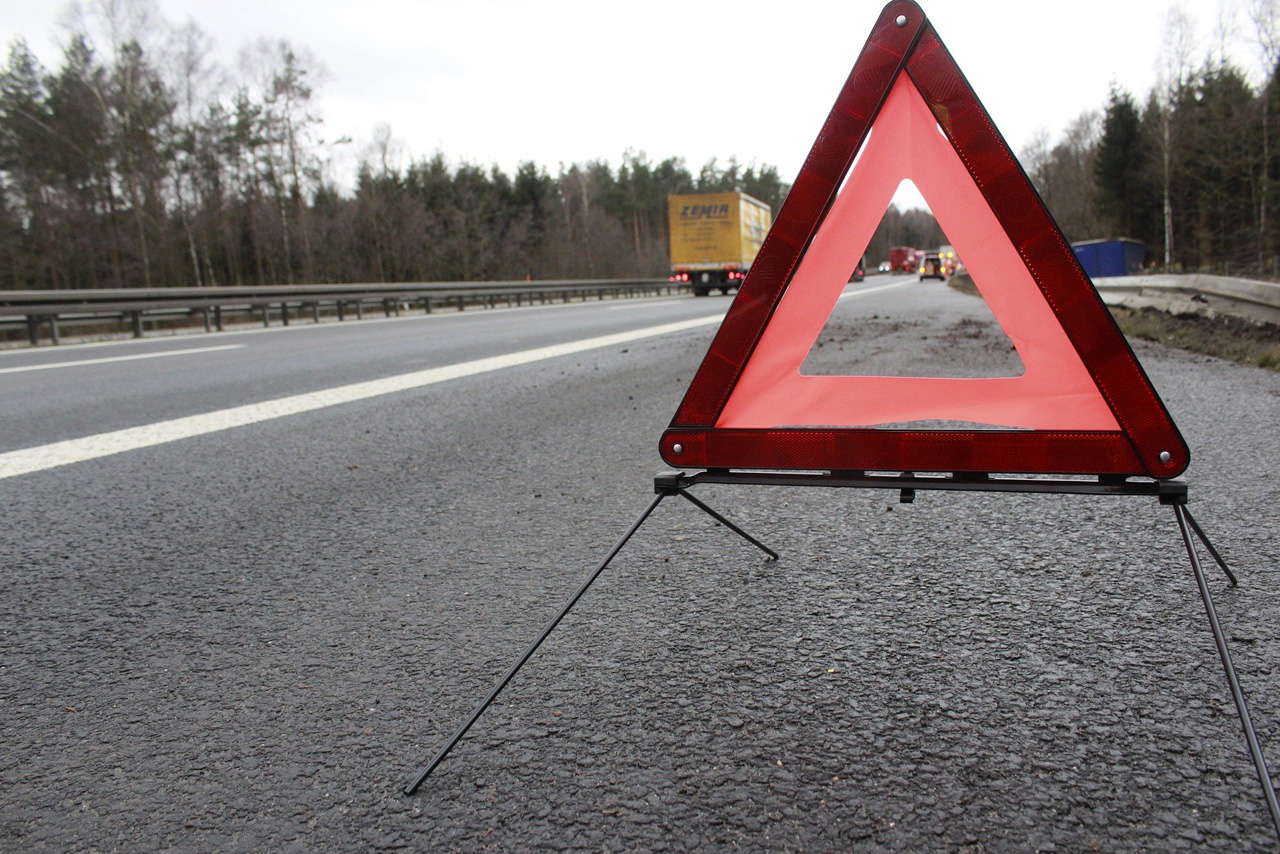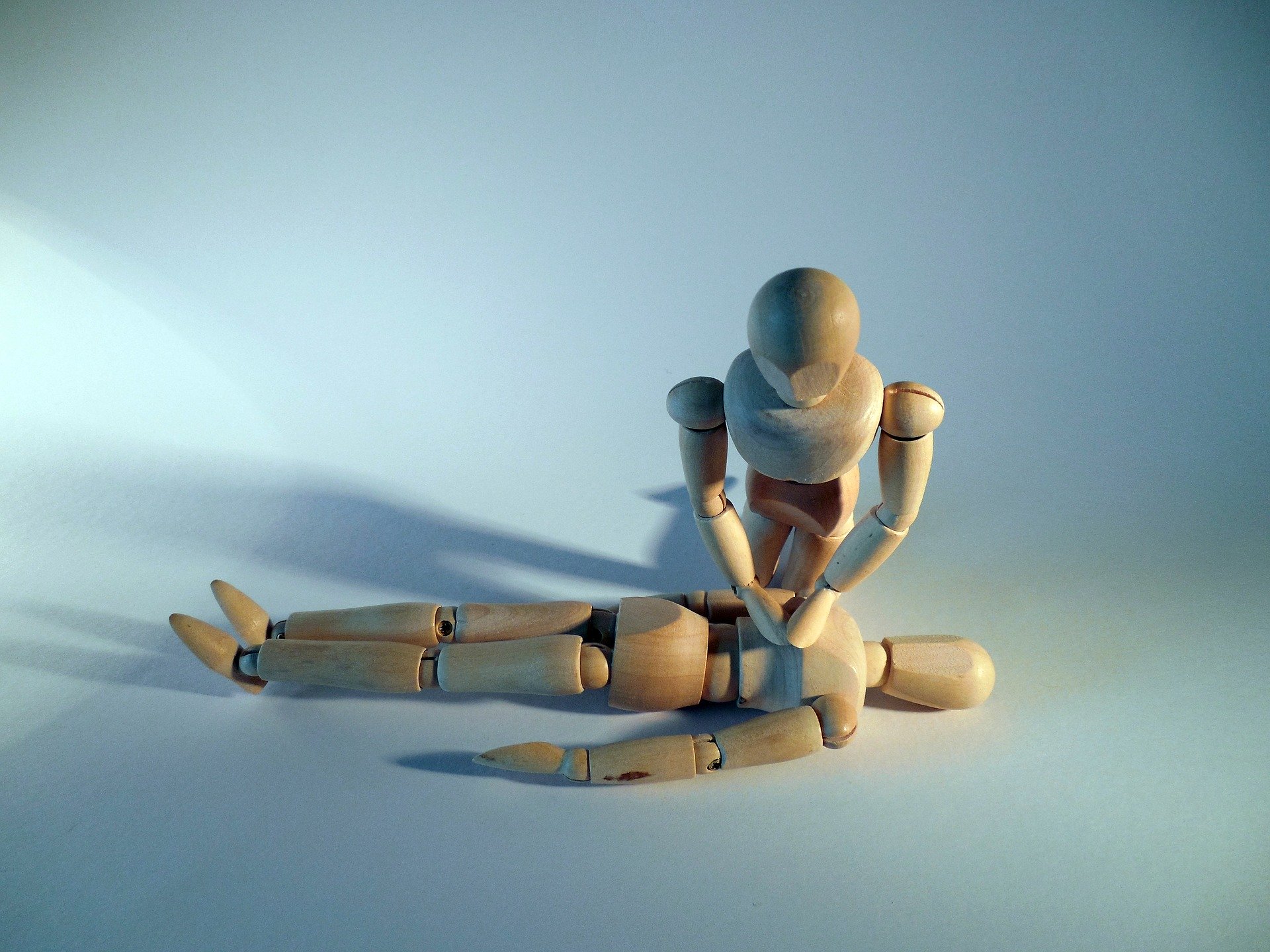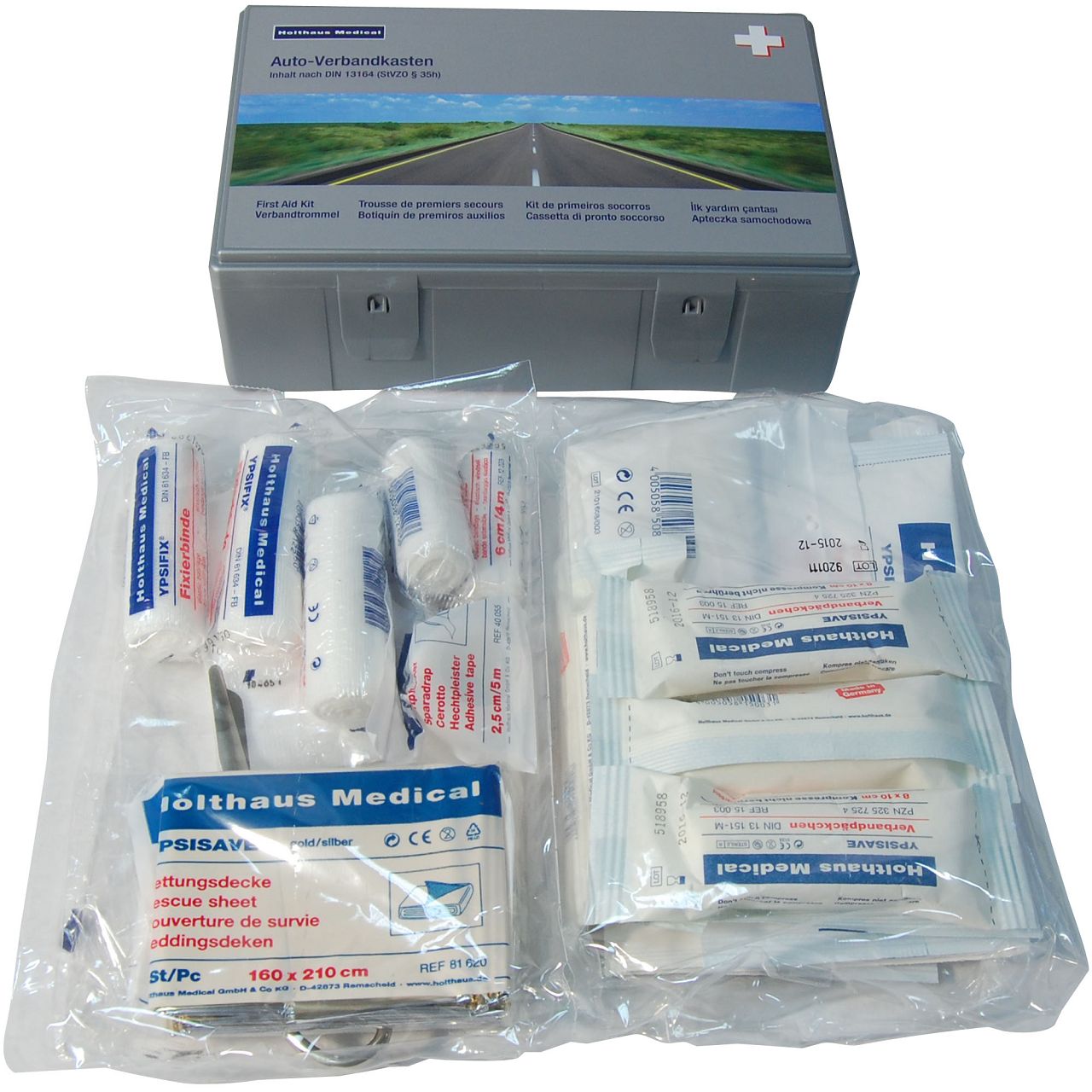First aid after a car accident
First aid in a traffic accident - hopefully you will never get into such a situation. But it can happen at any time that you are confronted with it. Accidents are constantly in the news, but very few people know how to behave properly. No matter if you are directly involved or if you have to witness an accident as a first aider, it is worth to be informed about the rescue steps. Because you yourself would surely prefer it if someone takes care of you in an accident and knows how to proceed.
Securing the accident site and making the emergency call
As first responder you should first of all switch on the hazard warning light. Afterwards, the accident site must be secured to prevent a subsequent accident. Even in an emergency, self-protection has the highest priority: Therefore, put on the warning vest, open the warning triangle and if possible go behind the crash barrier. In fast traffic, the warning triangle should be placed about 100 meters from the accident site. If possible, ask other road users for assistance.
Before dialling the single, Europe-wide number 112 for the emergency call, a brief look at the scene of the accident should be taken. Get an idea of the injuries and the number of people involved in the traffic accident. If a fire or leaking fuel poses a danger to the injured, first help them out of the vehicle. Provided you don't put yourself in danger!
Even if the control center dispatchers are trained to guide the caller through the conversation, it helps to go through the known W-questions beforehand.
These are the five W questions:
- Where did the accident happen?
- What happened?
- How many injured are there?
- What kind of injuries do the people have?
- Wait for confirmation. Please do not hang up the phone

The question about the wos is not always easy to explain on the phone in case of emergency and stress. The following options are available for determining the location before calling the emergency services:
- Inner town by street name and recognizable house number
- On the motorway there are station signs, which are placed at intervals of 500 metres. On these you will find the section and the kilometre indication. The direction of travel, i.e. the long-distance destination, must always be specified as well.
- When calling from an emergency telephone, the location is automatically communicated.
- You can use a navigation device for orientation when driving.
- The mobile phone can also be a great help by starting a navigation app to determine the location.
Give first aid
Until the rescue services arrive, valuable time passes for the injured. Therefore first aiders are asked to take care of the injured until they arrive. Depending on the severity of the injuries, you can save lives with simple first aid measures! As accidents have different degrees of severity, the measures are also different:
- The casualty is uninjured and responsive.
- Take him behind the guardrail and make sure he puts on the safety vest.
- Stay behind the guard rail with the casualty
- Start a conversation with the accident victim
- The accident victim is (slightly) injured, is breathing, is responsive and not in a dangerous situation.
- If the person is outside the vehicle, have him/her lie down or sit down at the side of the road, wrap him/her with the rescue blanket and talk to him/her. The rescue blanket can protect against wetness, cold and hypothermia with the silver side facing the accident victim. The golden side to the inside protects against heat.
- If the injured person is in the car, leave him sitting, wrap him with the blanket and place one hand on the windscreen on which the victim should concentrate. This will prevent the person from making panicky movements and causing further injury. Here too, you involve the victim in a conversation until the rescue services arrive.
- If possible, bandage open wounds and injuries with the means from the first aid kit , if possible
- The victim is seriously injured, unconscious, breathing and is outside the vehicle.
- Place the injured person in a stable lateral position.
- Keep him warm with the life blanket.
- If possible, bandage open wounds and injuries with the products from the first-aid kit
- The victim is seriously injured, unconscious, not breathing and is outside the vehicle.
- Begin resuscitation until the emergency services arrive.
- If the victim is to breathe on his own again, put him in a stable lateral position, keep him warm and take care of the wounds in first aid.
- The accident victim is injured and in a dangerous situation.
- Move the victim out of the danger zone, if necessary with the aid of the diamond-shaped handle.
- If the person is still breathing, place him/her in a stable lateral position, keep him/her warm and provide initial treatment of the wounds
- If the person is unconscious and not breathing, the first thing to do is to resuscitate.

Many accidents are just fender bends. In general, the persons concerned are approachable. Whether they have injuries or not, the important thing is to talk to them and reassure them. Make sure that the person concerned breathes evenly. Care is extremely important for the psyche. Many are still in shock and may be somewhat disoriented. Therefore a certain appearance of the first aider is useful so that they do not panic.
The following questions should be asked:
- What happened?
- How are you?
- Are you in pain?
- Are you on medication? If so, which ones?
These questions will help the rescue teams arriving later. In the event that the casualty becomes unconscious, the first aider can provide information.
Which is also good to know in an emergency.
If an injured person is in shock, it can also help to put them on their back and put their legs up. This improves the blood supply to the brain. If you are the first aider and find an unconscious motorcyclist, you must remove his helmet. The neck should be moved as little as possible and stabilized safely - this is best done in pairs. Only then can the biker be properly supplied.
Concrete first-aid measures briefly presented
If the person is motionless or seriously injured after the traffic accident, we have summarized the most important first aid measures here:

Wound care after a traffic accident
If the accident victim is breathing but has suffered serious injuries, the bleeding must be stopped. First of all, you should put on the gloves from the first-aid kit to protect yourself from infection. It should not be placed in the wound and no water should be used for rinsing. If possible, the affected body part should be elevated. In addition, the person should sit or lie down, as a shock could cause him or her to faint suddenly. Now place a sterile dressing on the wound and fix it with a bandage. The wound dressing from the first aid kit must be applied with pressure on the wound, but must not be too tight, so as not to interrupt the blood supply.
Stable lateral position
If an injured person is unconscious and breathing normally, the stable lateral position can be used to prevent respiratory arrest or suffocation. Foreign bodies, vomit or blood can drain off, as the mouth becomes the lowest point of the body. To do this, kneel at the side of the affected person and place the arm facing you at an angle upwards. Now stretch your legs, grab the leg further away and turn the accident victim towards you. Here's a little tip: Stand with the back leg up and pull the knee towards you. This makes use of the leverage effect and less effort is required. The upper arm is now angled and with the palm of your hand facing up, place your hand under your cheek. Now stretch the neck a little and open the mouth of the accident victim. The hand lying on the cheek should be aligned so that the neck remains overstretched.
cardiac massage and respiration
If the person is unconscious and is not breathing normally, you must start resuscitation. Make sure to make the emergency call first, because in the worst case, they will carry out the resuscitation until the rescue services arrive! For resuscitation, place your hands on top of each other on the middle of the chest. Now quickly press down about 5cm 30 times. Now hold your nose closed and blow air into your mouth twice for one second. As soon as the chest is lowered again, press again Tip: If you do not want to do mouth-to-mouth ventilation, blow into the nose. Alternatively, you can buy ventilation wipes with a one-way valve. Among other things, this protects you from contact with blood and secretions.
The rhombic handle - only as a stopgap solution!
An accident victim should only be rescued from the vehicle if it is in an absolute emergency situation, e.g. if the vehicle is on fire, threatens to slide off or the person is no longer breathing. And then only if the first aider does not put himself in danger. One possibility for salvage is the rautek handle. However, with this rescue handle the spine of the accident victim is moved and not stabilized, so injuries could be aggravated.
In brief, the rescue handle works as follows: For the diamond-shaped handle, first open the vehicle door and try to address the accident victim. Switch off the ignition and never put your head between the deployed airbag and the injured. Turn the back of the injured person towards you, making sure that the feet of the victim are not trapped. Now reach from behind along the armpits between arm and body and place one of the victim's forearms in front of his stomach. Grasp the arm from above with both hands. You can now pull the person to a safe place by the forearm. With the Rautek handle it is therefore possible to move even people who are heavier than yourself. In a video of the Johanniter-Unfall-Hilfe, the rhombic handle 3 is presented visually in a short and simple way.
The car first aid kit according to DIN 13164
In order to be able to carry out the first aid measures at all, it is important to carry a valid first aid kit in the car. This should meet the standard 13164, then you can be sure that all necessary materials including the rescue blanket are included. In addition, attention must be paid to the best before date, which is prescribed by the Medical Devices Act.
In addition to the first aid kit, we recommend that you have a emergency breakdown kit, a sufficient number of warning vests (one is mandatory, one vest per passenger is recommended) and a warning triangle in your car. Also helpful is a emergency hammer, with which slices can be smashed and belts cut. Sometimes this emergency hammer is also available in combination with a warning light or flashlight. The warning light can then be placed on the roof of the car in the dark, so that you can be seen even better by other car drivers.
To complete the equipment it is advisable to carry a so-called rescue card in the car. These were compiled by the ADAC and are available for each model. The rescue maps show the body reinforcements, the location of the tank and the gas pressure shock absorbers. This makes the rescue easier for the rescuers, as they can see more quickly where and how they can best get into or open the vehicle. The rescue cards should always be jammed with the image facing outwards under the driver's sun visor. This location is internationally communicated. In addition, you can get a sticker from the ADAC, which is attached to the windscreen. This also indicates that a rescue card is available in the vehicle.
We recommend to refresh the first aid course regularly. This increases the willingness of the first aider to help in the event of a traffic accident and probably also takes away the inhibitions of many a person in such a situation. The first aid app of the German Red Cross is also helpful, which guides you through an emergency situation with instructions and pictures. In addition, a well-filled and up-to-date first aid or breakdown kit should always be in your car. In addition, it helps to be familiar with the various first aid measures such as the rhombic grip, the stable lateral position and resuscitation and not to look away under any circumstances. We wish you a safe journey at all times!
To the breakdown and emergency kits



